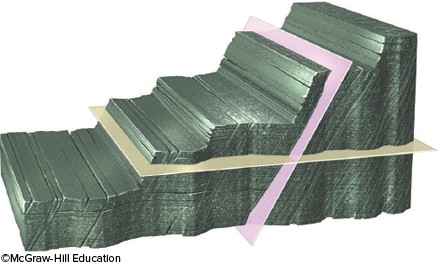Describe four common types of faults and the key characteristics or motion of each
What will be an ideal response?
ANSWER: Normal faults involve motion at a divergent boundary where rock above the fault slips down and over the rocks beneath the fault.
Reverse faults involve motion of rock on the upper side of a fault up and over rock beneath the fault.
Strike-slip faults involve motion at a transform boundary and involve horizontal motion parallel to the fault.
Thrust faults are similar to reverse faults, but the fault surface is more gently inclined. Blind thrust faults involve motion that does not reach the surface.
You might also like to view...
World-empires in Asia that relied upon large-scale irrigation and drainage schemes for agricultural productivity are known as hydraulic societies
Indicate whether this statement is true or false.
Dry snow avalanches behave like a fluid. Indicate whether the statement is true or false
What type of cleavage is illustrated in this figure? 
A. two nonperpendicular directions B. three nonperpendicular directions C. one direction D. two perpendicular directions E. three perpendicular directions
How does mining affect soils?
What will be an ideal response?